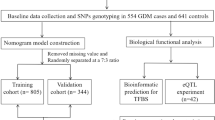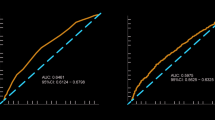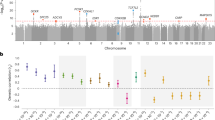Abstract
Gestational diabetes mellitus (GDM) is common in Japanese women, posing serious risks to mothers and offspring. This study investigated the influence of maternal genotypes on the risk of GDM and examined how these genotypes modify the effects of psychological and dietary factors during pregnancy. We analyzed data from 20,399 women in the Tohoku Medical Megabank Project Birth and Three-Generation Cohort. Utilizing two customized SNP arrays for the Japanese population (Affymetrix Axiom Japonica Array v2 and NEO), we performed a meta-analysis to combine the datasets. Gene-environment interactions were assessed by modeling interaction terms between genome-wide significant single nucleotide polymorphisms (SNPs) and psychological and dietary factors. Our analysis identified two SNP variants, rs7643571 (p = 9.14 × 10−9) and rs140353742 (p = 1.24 × 10−8), located in an intron of the MDFIC2 gene, as being associated with an increased risk of GDM. Additionally, although there were suggestive patterns for interactions between these SNPs and both dietary factors (e.g., carbohydrate and fruit intake) and psychological distress, none of the interaction terms remained significant after Bonferroni correction (p < 0.05/8). While nominal significance was observed in some models (e.g., psychological distress, p = 0.04), the data did not provide robust evidence of effect modification on GDM risk once adjusted for multiple comparisons. These findings reveal novel genetic associations with GDM in Japanese women and highlight the importance of gene-environment interactions in its etiology. Given that previous genome-wide association studies (GWAS) on GDM have primarily focused on Western populations, our study provides new insights by examining an Asian population using a population-specific array.
This is a preview of subscription content, access via your institution
Access options
Subscribe to this journal
Receive 12 print issues and online access
$259.00 per year
only $21.58 per issue
Buy this article
- Purchase on SpringerLink
- Instant access to full article PDF
Prices may be subject to local taxes which are calculated during checkout


Similar content being viewed by others
Data availability
We will upload our GWAS summary statistics to J-Morp (https://jmorp.megabank.tohoku.ac.jp/), the Japanese Multi Omics Reference Panel, a widely used public database for genomic data in the Japanese population. Individual genotyping results and other cohort data used for the association study are stored in Tohoku Medical Megabank Organization. In response to reasonable requests for these data, we will assemble and share the stored data after approval of the Ethics Committee and the Materials and Information Distribution Review Committee of Tohoku Medical Megabank Organization.
References
American College of Obstetricians & Gynecology. ACOG Practice Bulletin No. 190: Gestational Diabetes Mellitus. Obstet Gynecol. 2018;131:e49–e64.
Dabelea D, Snell-Bergeon JK, Hartsfield CL, Bischoff KJ, Hamman RF, McDuffie RS, et al. Increasing prevalence of gestational diabetes mellitus (GDM) over time and by birth cohort: Kaiser Permanente of Colorado GDM Screening Program. Diabetes Care. 2005;28:579–84.
The Japan Endocrine Society (2023) Gestational diabetes mellitus. [Available from https://www.j-endo.jp/modules/patient/index.php?content_id=94] (Accessed 6/19 2023) in Japanese.
Mizuno S, Nishigori H, Sugiyama T, Takahashi F, Iwama N, Watanabe Z, et al. Association between social capital and the prevalence of gestational diabetes mellitus: An interim report of the Japan Environment and Children’s Study. Diabetes Res Clin Pract. 2016;120:132–41.
McAllister K, Mechanic LE, Amos C, Aschard H, Blair IA, Chatterjee N, et al. Current Challenges and New Opportunities for Gene-Environment Interaction Studies of Complex Diseases. Am J Epidemiol. 2017;186:753–61.
Palma-Gudiel H, Cordova-Palomera A, Eixarch E, Deuschle M, Fananas L. Maternal psychosocial stress during pregnancy alters the epigenetic signature of the glucocorticoid receptor gene promoter in their offspring: a meta-analysis. Epigenetics. 2015;10:893–902.
Marceau K, Hajal N, Leve LD, Reiss D, Shaw DS, Ganiban JM, et al. Measurement and associations of pregnancy risk factors with genetic influences, postnatal environmental influences, and toddler behavior. Int J Behav Dev. 2013;37:366–75.
Dewell S, Slater D, Benzies K, McDonald S, Tough S. Relationship Between Psychosocial Distress in Pregnancy and Two Genes Associated With Human Social Interaction: A Pilot Study. SAGE Open Nurs. 2018;4:2377960818765272.
Kuriyama S, Metoki H, Kikuya M, Obara T, Ishikuro M, Yamanaka C, et al. Cohort Profile: Tohoku Medical Megabank Project Birth and Three-Generation Cohort Study (TMM BirThree Cohort Study): rationale, progress and perspective. Int J Epidemiol. 2020;49:18–19m.
Kawai Y, Mimori T, Kojima K, Nariai N, Danjoh I, Saito R, et al. Japonica array: improved genotype imputation by designing a population-specific SNP array with 1070 Japanese individuals. J Hum Genet. 2015;60:581–7.
Sakurai-Yageta M, Kumada K, Gocho C, Makino S, Uruno A, Tadaka S, et al. Japonica Array NEO with increased genome-wide coverage and abundant disease risk SNPs. J Biochem. 2021;170:399–410.
International Association of D, Pregnancy Study Groups Consensus P, Metzger BE, Gabbe SG, Persson B, Buchanan TA, et al. International association of diabetes and pregnancy study groups recommendations on the diagnosis and classification of hyperglycemia in pregnancy. Diabetes Care. 2010;33:676–82.
Morikawa M, Yamada T, Yamada T, Akaishi R, Nishida R, Cho K, et al. Change in the number of patients after the adoption of IADPSG criteria for hyperglycemia during pregnancy in Japanese women. Diabetes Res Clin Pract. 2010;90:339–42.
Japan Society of Obstetrics and Gynecology. Opinion on “Definition and Diagnostic Criteria for Gestational Diabetes Mellitus” 2023 [Available from https://www.jsog.or.jp/kaiin/html/H14_2.html] (Accessed in 6/19 2023) in Japanese.
Okajima I, Miyamoto T, Ubara A, Omichi C, Matsuda A, Sumi Y, et al. Evaluation of Severity Levels of the Athens Insomnia Scale Based on the Criterion of Insomnia Severity Index. Int J Environ Res Public Health. 2020;17:8789.
Tomioka K, Iwamoto J, Saeki K, Okamoto N. Reliability and validity of the International Physical Activity Questionnaire (IPAQ) in elderly adults: the Fujiwara-kyo Study. J Epidemiol. 2011;21:459–65.
Jung M, Lin L, Viswanath K. Associations between health communication behaviors, neighborhood social capital, vaccine knowledge, and parents’ H1N1 vaccination of their children. Vaccine. 2013;31:4860–6.
Sampson RJ, Raudenbush SW, Earls F. Neighborhoods and violent crime: a multilevel study of collective efficacy. Science. 1997;277:918–24.
Nawa N, Fujiwara T. Association between social capital and second dose of measles vaccination in Japan: Results from the A-CHILD study. Vaccine. 2019;37:877–81.
Nawa N, Isumi A, Fujiwara T. Community-level social capital, parental psychological distress, and child physical abuse: a multilevel mediation analysis. Soc Psychiatry Psychiatr Epidemiol. 2018;53:1221–29.
Berkman LF, Syme SL. Social networks, host resistance, and mortality: a nine-year follow-up study of Alameda County residents. Am J Epidemiol. 1979;109:186–204.
Ikeda A, Iso H, Kawachi I, Yamagishi K, Inoue M, Tsugane S, et al. Social support and stroke and coronary heart disease: the JPHC study cohorts II. Stroke. 2008;39:768–75.
Ikeda A, Kawachi I, Iso H, Inoue M, Tsugane S, Group JS. Gender difference in the association between social support and metabolic syndrome in Japan: the ‘enkai’ effect? J Epidemiol Community Health. 2011;65:71–7.
Ikehara S, Iso H, Yamagishi K, Yamamoto S, Inoue M, Tsugane S, et al. Alcohol consumption, social support, and risk of stroke and coronary heart disease among Japanese men: the JPHC Study. Alcohol Clin Exp Res. 2009;33:1025–32.
Sakurai K, Nishi A, Kondo K, Yanagida K, Kawakami N. Screening performance of K6/K10 and other screening instruments for mood and anxiety disorders in Japan. Psychiatry Clin Neurosci. 2011;65:434–41.
Date C, Yamaguchi M, Tanaka H. Development of a food frequency questionnaire in Japan. J Epidemiol. 1996;6:S131–6.
Centers for Disease Control and Prevention. Defining Adult Overwight & obesity. 2022 [updated 2022-10-20T02:16:01Z. Available from https://www.cdc.gov/obesity/basics/adult-defining.html] (Accessed in 6/19 2023).
Kominiarek MA, Peaceman AM. Gestational weight gain. Am J Obstet Gynecol. 2017;217:642–51.
Rasmussen KM, Yaktine AL, eds. Weight Gain During Pregnancy: Reexamining the Guidelines. Washington (DC): National Academies Press (US); 2009.
Yamada M, Motoike IN, Kojima K, Fuse N, Hozawa A, Kuriyama S, et al. Genetic loci for lung function in Japanese adults with adjustment for exhaled nitric oxide levels as airway inflammation indicator. Commun Biol. 2021;4:1288.
O’Connell J, Gurdasani D, Delaneau O, Pirastu N, Ulivi S, Cocca M, et al. A general approach for haplotype phasing across the full spectrum of relatedness. PLoS Genet. 2014;10:e1004234.
Tadaka S, Katsuoka F, Ueki M, Kojima K, Makino S, Saito S, et al. 3.5KJPNv2: an allele frequency panel of 3552 Japanese individuals including the X chromosome. Hum Genome Var. 2019;6:28.
Genomes Project C, Auton A, Brooks LD, Durbin RM, Garrison EP, Kang HM, et al. A global reference for human genetic variation. Nature. 2015;526:68–74.
Bycroft C, Freeman C, Petkova D, Band G, Elliott LT, Sharp K, et al. The UK Biobank resource with deep phenotyping and genomic data. Nature. 2018;562:203–09.
Howie BN, Donnelly P, Marchini J. A flexible and accurate genotype imputation method for the next generation of genome-wide association studies. PLoS Genet. 2009;5:e1000529.
Takahashi I, Ohseto H, Ueno F, Onuma T, Narita A, Obara T, et al. Genom wide association study based on clustering by obesity-related varabls shed light on a genetic architecture of obesity in Japan and UK population. Heliyon. 2024;10:e36023.
Willer CJ, Li Y, Abecasis GR. METAL: fast and efficient meta-analysis of genomewide association scans. Bioinformatics. 2010;26:2190–1.
Thiese MS, Ronna B, Ott U. P value interpretations and considerations. J Thorac Dis. 2016;8:E928–E31.
Pervjakova N, Moen GH, Borges MC, Ferreira T, Cook JP, Allard C, et al. Multi-ancestry genome-wide association study of gestational diabetes mellitus highlights genetic links with type 2 diabetes. Hum Mol Genet. 2022;31:3377–91.
Elliott A, Walters RK, Pirinen M, Kurki M, Junna N, Goldstein JI, et al. Distinct and shared genetic architectures of gestational diabetes mellitus and type 2 diabetes. Nat Genet. 2024;56:377–82.
Kwak SH, Kim SH, Cho YM, Go MJ, Cho YS, Choi SH, et al. A genome-wide association study of gestational diabetes mellitus in Korean women. Diabetes. 2012;61:531–41.
Zhen J, Gu Y, Wang P, Wang W, Bian S, Huang S, et al. Genome-wide association and Mendelian randomisation analysis among 30,699 Chinese pregnant women identifies novel genetic and molecular risk factors for gestational diabetes and glycaemic traits. Diabetologia. 2024;67:703–13.
Caughey AB, Cheng YW, Stotland NE, Washington AE, Escobar GJ. Maternal and paternal race/ethnicity are both associated with gestational diabetes. Am J Obstet Gynecol. 2010;202:616.e1–5.
Cormier H, Vigneault J, Garneau V, Tchernof A, Vohl MC, Weisnagel SJ, et al. An explained variance-based genetic risk score associated with gestational diabetes antecedent and with progression to pre-diabetes and type 2 diabetes: a cohort study. BJOG. 2015;122:411–9.
Bustamante CD, Burchard EG, De la Vega FM. Genomics for the world. Nature. 2011;475:163–5.
Popejoy AB, Fullerton SM. Genomics is failing on diversity. Nature. 2016;538:161–64.
Prudencio CB, Nunes SK, Pinheiro FA, Sartorao Filho CI, Nava GTA, Salomoni SE, et al. Gestational diabetes is associated with alteration on pelvic floor muscle activation pattern during pregnancy and postpartum: Prospective cohort using electromyography assessment. Front Endocrinol. 2022;13:958909.
Shin Y, Moon JH, Oh TJ, Ahn CH, Moon JH, Choi SH, et al. Higher Muscle Mass Protects Women with Gestational Diabetes Mellitus from Progression to Type 2 Diabetes Mellitus. Diabetes Metab J. 2022;46:890–900.
Wang LK, Paidisetty PS, Cano AM. The next paradigm shift? ChatGPT, artificial intelligence, and medical education. Med Teach. 2023;45:925.
Shou J, Chen PJ, Xiao WH. Mechanism of increased risk of insulin resistance in aging skeletal muscle. Diabetol Metab Syndr. 2020;12:14.
Mutie PM, Giordano GN, Franks PW. Lifestyle precision medicine: the next generation in type 2 diabetes prevention? BMC Med. 2017;15:171.
Rich SS. Diabetes: Still a geneticist’s nightmare. Nature. 2016;536:37–8.
Hayes MG, Urbanek M, Hivert MF, Armstrong LL, Morrison J, Guo C, et al. Identification of HKDC1 and BACE2 as genes influencing glycemic traits during pregnancy through genome-wide association studies. Diabetes. 2013;62:3282–91.
Benetti E, Mastrocola R, Rogazzo M, Chiazza F, Aragno M, Fantozzi R, et al. High sugar intake and development of skeletal muscle insulin resistance and inflammation in mice: a protective role for PPAR- delta agonism. Mediators Inflamm 2013;2013:509502.
Funding
This work was supported by the National Institutes of Health (NIH) (grant R21 HD101778)
Author information
Authors and Affiliations
Contributions
Nobutoshi Nawa, Toshihiro Tanaka, Wendy L. Bennett, Margaret A. Taub, Pamela J. Surkan, Shinichi Kuriyama, and Takeo Fujiwara contributed to the conception and design of the study. Tomoki Kawahara, Nobutoshi Nawa, Pamela J. Surkan, Margaret A. Taub, Wendy L. Bennett, and Takeo Fujiwara contributed to the oversight of this analysis and interpretation of the results. Tomoki Kawahara, Nobutoshi Nawa, and Takeo Fujiwara were responsible for data analysis. Tomoki Kawahara and Nobutoshi Nawa drafted the initial manuscript. Keiko Murakami, Hisashi Ohseto, Ippei Takahashi, Akira Narita, Taku Obara, Mami Ishikuro, Masatsugu Orui, Aoi Noda, Genki Shinoda, Yuki Nagata, Satoshi Nagaie, Soichi Ogishima, Junichi Sugawara, Shigeo Kure, Kengo Kinoshita, Atsushi Hozawa, Nobuo Fuse, and Gen Tamiya contributed to data collection and management. Takeo Fujiwara and Nobutoshi Nawa served as guarantors, with full access to all study data and responsibility for the integrity and accuracy of the data analysis. All authors reviewed, provided critical revisions, and approved the final manuscript.
Corresponding author
Ethics declarations
Competing interests
Funding for the study described in this publication included a subaward agreement to Institute of Science Tokyo, formerly Tokyo Medical and Dental University. PJS also maintains a paid academic appointment at Institute of Science Tokyo. This arrangement has been reviewed and approved by the Johns Hopkins University in accordance with its conflict-of-interest policies.
Additional information
Publisher’s note Springer Nature remains neutral with regard to jurisdictional claims in published maps and institutional affiliations.
Supplementary information
Rights and permissions
Springer Nature or its licensor (e.g. a society or other partner) holds exclusive rights to this article under a publishing agreement with the author(s) or other rightsholder(s); author self-archiving of the accepted manuscript version of this article is solely governed by the terms of such publishing agreement and applicable law.
About this article
Cite this article
Kawahara, T., Nawa, N., Murakami, K. et al. Genetic effects on gestational diabetes mellitus and their interactions with environmental factors among Japanese women. J Hum Genet 70, 265–273 (2025). https://doi.org/10.1038/s10038-025-01330-4
Received:
Accepted:
Published:
Issue date:
DOI: https://doi.org/10.1038/s10038-025-01330-4



